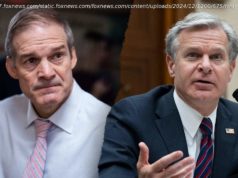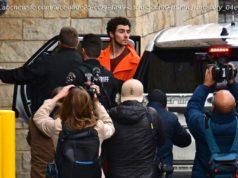Dr. Blasey testifies before the Senate Judiciary Committee about sexual misconduct claims against Judge Brett M. Kavanaugh, President Trump’s Supreme Court nominee.
Right Now: The Senate Judiciary Committee is in recess for lunch.
• Christine Blasey Ford said she was “terrified” but delivered an emotional opening statement to the Senate Judiciary Committee about her accusation that Judge Brett M. Kavanaugh, President Trump’s Supreme Court nominee, sexually assaulted her.
• Judge Kavanaugh’s confirmation was thrown into turmoil after Dr. Blasey came forward with the claim that he assaulted her at a gathering when they were both in high school. He denies it. Two more women have accused him of sexual misconduct at parties in high school and in college, which he has also denied.
• Republicans have ceded their five-minute question periods to a veteran prosecutor, Rachel Mitchell, though also reserved their ability to question her. Democrats are questioning Dr. Blasey themselves.
Shadowy theories that Dr. Blasey could have mistaken the identity of her assailant have bounced through Washington’s conservative circles for days. And on Wednesday night, just hours before the hearing, Republicans on the Judiciary Committee released a document detailing their investigative work that showed they had interviewed two separate men who said they believed that they, not Judge Kavanaugh, assaulted Dr. Blasey. Even Judge Kavanaugh has speculated that perhaps Dr. Blasey was misremembering the incident.
As other senators sought to clarify Dr. Blasey’s memory, Senator Richard J. Durbin, Democrat of Illinois, took the question head on.
“I am asking you to address this new defense of mistaken identity directly,” he said. “Dr. Ford with what degree of certainly do you believe Judge Kavanaugh assaulted you?”
Dr. Blasey, who sometimes uses her married name Ford, responded unequivocally.
“100 percent,” Dr. Blasey said.
— Nicholas Fandos
During the questioning, Dr. Blasey’s background as a professor of psychology affiliated with Stanford University and Palo Alto University shaped her answers to questions. For example, describing the lingering consequences of having been attacked as a teenager, she invoked an obscure term — sequela — which refers to aftereffects of a disease or traumatic incident.
Asked how she remembers that it was Judge Kavanaugh and not some other person who attacked her, she answered clinically with a description of how memories of traumatic events form in the brain: “Just basic memory functions and also just the level of norepinephrine and the epinephrine in the brain that sort of, as you know, encodes — that neurotransmitter that codes memories into the hippocampus and so the trauma-related experience is locked there whereas other details kind of drift.”
Senator Feinstein responded: “So what you are telling us is this could not be a case of mistaken identity.”
“Absolutely not,” Dr. Blasey replied.
And, a bit later, asked what her strongest memory was, something she could not forget, she replied: “Indelible into the hippocampus is the laughter — the uproarious laughter between the two, and their having fun at my expense.”
— Charlie Savage
Republicans said they chose to turn over their questions to Ms. Mitchell, a sex crimes prosecutor, so that they could have a more targeted, coherent hearing. But as her questioning began, the arrangement appeared more halting and cumbersome than efficient, as it resembled a courtroom trial than a typical Senate hearing.
The juxtaposition was jarring, particularly with Democrats using their time to cut straight to the heart of Dr. Blasey’s story. After Dr. Blasey’s opening statement gripped the hearing room, Ms. Mitchell immediately dug into granular details, asking the witness to read and correct messages she exchanged with a reporter at The Washington Post and a letter shared with Ms. Feinstein.
“The first two texts were sent by you on July 6, is that correct?” Ms. Mitchell asked. Dr. Ford spent long moments reading printouts of both and began to work through technical corrections.
And with only five minute blocks at her disposal, Ms. Mitchell was repeatedly cut off midquestioning.
“Miss Mitchell, I don’t know whether this is fair to interrupt, I want to keep people within five minutes,” Mr. Grassley said. “Is that a major problem for you in the middle of a question?”
— Nicholas Fandos
A group of 10 women watching the hearings in Bangor, Me. — the home state of Senator Susan Collins, whose vote will be pivotal in Judge Kavanaugh’s confirmation, started out suspicious that Dr. Blasey had partisan motivations; some declared they believed her, while others said they were determined to approach the hearings with an open mind.
Jean Barry, a high school science teacher and a firm opponent of abortion rights, began listening to the hearing concerned about the timing of the accusations.
“So far she seems somewhat credible, like she’s telling us something that happened from her heart,” she said.
Emily McLaughlin, a sophomore at the University of Maine who was a treasurer for the college Republicans, said she believed Dr. Blasey, but wanted to hear from Judge Kavanaugh and wondered, too, whether she just had one beer.
During the short recess, the group had a lively back and forth. While most believed Dr. Blasey, some were waiting to hear further questioning and believed it was important to hear Judge Kavanaugh. They gathered again around the television as the hearings resumed, listening intently.
— Susan Chira
Dr. Blasey, who has made her fear of flying clear, said that taking a polygraph test was almost as anxiety-provoking as an airplane flight. But her polygraph test did come out “no deception indicated.”
Judge Kavanaugh has written that polygraph tests have a role to play in law enforcement. In a 2016 opinion for a unanimous three-judge panel of his court, he ruled that the Department of Defense could withhold reports concerning the effectiveness of polygraph tests in response to request under the Freedom of Information Act.
The studies were exempt from disclosure, Judge Kavanaugh wrote, because they concerned “an important law enforcement tool.”
“The government has satisfactorily explained how polygraph examinations serve law enforcement purposes,” he wrote. “It has also explained how the reports assessing the efficacy of those examinations and identifying needed fixes likewise serve law enforcement purposes. Put simply, the reports help ensure that law enforcement officers optimally use an important law enforcement tool.”
— Adam Liptak
Dr. Blasey delivered her opening statement, at times through tears, at times resolute — but always with palpable emotion.
[ Read Dr. Blasey’s prepared opening statement here.]
Speaking her first words in public, Dr. Blasey told senators in explicit detail, her voice breaking at times, of the night she said the future Judge Kavanaugh pinned her to the bed, tried to rip her clothes off and clapped his hand over her mouth as she screamed.
“It was hard for me to breathe and I believed that Brett was going to accidentally kill me,” she said.
Dr. Blasey also described the lasting impact of the attack, especially how he held his hand over her mouth: “Brett’s assault on me drastically altered my life.”
And today, she said death threats and vile epithets have “rocked me to my core.”
The main test for Dr. Blasey was whether she could appear credible before the senators, especially Republicans who have suggested that she is suffering from a case of mistaken identity — or that she has partisan motives.
She addressed the latter issue directly.
“I have been accused of acting out of partisan political motives,” she said. “Those who say that do not know me. I am a fiercely independent person, and I am no one’s pawn. My motivation in coming forward was to provide the facts about how Mr. Kavanaugh’s actions have damaged my life, so that you can take that into serious consideration as you make your decision about how to proceed.”
She also poked holes in the mistaken identity theory when she described how she and Judge Kavanaugh met when their social circles intersected. She remembered his friends, including Mark Judge, who she said was in the room, while practicing swimming and diving at Columbia Country Club in suburban Maryland.
“This is how I met Brett Kavanaugh, the boy who eventually assaulted me,” she said.
Senator Charles E. Grassley of Iowa, the chairman of the Judiciary Committee, when asked if he found Dr. Blasey credible, answered, “Let me suggest this. I know that we’ve got to take what she says very seriously.”
— Sheryl Gay Stolberg
Dr. Blasey entered the hearing room flanked by two of her lawyers, Debra Katz on her right and Michael Bromwich on her left.
Dr. Blasey’s entourage in the hearing room where she will testify includes friends who traveled with her from California to provide moral support, according to a person familiar with her appearance. The group does not include her husband, Russell Ford, who stayed behind with the couple’s children.
The family has faced multiple threats since Dr.
Home
United States
USA — Political Kavanaugh Hearing Live Updates: Christine Blasey Ford Is ‘100%’ Certain Assailant Was...






